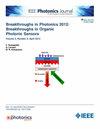Demonstration of Bi-Directional Point-to-Multipoint Coherent PON Using Digital Subcarrier Multiplexing for Broadband Access and Wireless Fronthaul
IF 2.4
4区 工程技术
Q3 ENGINEERING, ELECTRICAL & ELECTRONIC
引用次数: 0
Abstract
The integration of fiber and wireless communications presents a promising avenue to enhance communication networks, supporting the evolution of 5G-A/6G technologies, which includes upgrades to traditional access networks and mobile X-haul. We propose a point-to-multipoint (PtMP) coherent passive optical network (PON) architecture based on digital subcarrier multiplexing (DSCM) supporting fiber-wireless convergence scenarios as a promising solution for fixed and mobile access networks. The characteristics and potential applications of coherent PON, DSCM, and analog fiber-wireless transmission technologies are analyzed in the context of access networks. To evaluate our proposed scheme, we demonstrated a rate-flexible PtMP coherent PON architecture with downlink and uplink using DSCM to support fixed broadband access and W-band millimeter wave (mm-Wave) wireless access simultaneously. The architecture implements four 25G subcarriers for downstream and up to four 25G (fiber-wired) /12.5G (mm-Wave wireless) subcarriers for upstream, respectively. The results show that over 40 dB/42 dB power budget at SD-FEC threshold in fixed broadband access downstream/upstream transmission can be achieved, and over 34 dB/47 dB power budget in mm-Wave wireless access downstream/upstream (50G) transmission can be achieved, respectively. This scheme offers a favorable balance between system complexity and cost-effectiveness for next-generation optical networks and wireless access in the 5G-A/6G era.用于宽带接入和无线前传的数字子载波复用双向点对多点相干PON的演示
光纤和无线通信的集成为增强通信网络提供了一条有前途的途径,支持5G-A/6G技术的发展,包括对传统接入网和移动X-haul的升级。我们提出了一种基于数字子载波复用(DSCM)的点对多点(PtMP)相干无源光网络(PON)架构,支持光纤-无线融合场景,作为固定和移动接入网络的一种有前途的解决方案。在接入网的背景下,分析了相干PON、DSCM和模拟光纤无线传输技术的特点和潜在应用。为了评估我们提出的方案,我们展示了一个速率灵活的PtMP相干PON架构,该架构使用DSCM同时支持固定宽带接入和w波段毫米波(mm-Wave)无线接入,该架构具有下行链路和上行链路。该架构为下游实现了4个25G子载波,为上游实现了多达4个25G(光纤有线)/12.5G(毫米波无线)子载波。结果表明,固定宽带接入下行/上行传输在SD-FEC阈值下可实现40 dB/42 dB以上功率预算,毫米波无线接入下行/上行(50G)传输可实现34 dB/47 dB以上功率预算。该方案为5G-A/6G时代的下一代光网络和无线接入提供了系统复杂性和成本效益之间的良好平衡。
本文章由计算机程序翻译,如有差异,请以英文原文为准。
求助全文
约1分钟内获得全文
求助全文
来源期刊

IEEE Photonics Journal
ENGINEERING, ELECTRICAL & ELECTRONIC-OPTICS
CiteScore
4.50
自引率
8.30%
发文量
489
审稿时长
1.4 months
期刊介绍:
Breakthroughs in the generation of light and in its control and utilization have given rise to the field of Photonics, a rapidly expanding area of science and technology with major technological and economic impact. Photonics integrates quantum electronics and optics to accelerate progress in the generation of novel photon sources and in their utilization in emerging applications at the micro and nano scales spanning from the far-infrared/THz to the x-ray region of the electromagnetic spectrum. IEEE Photonics Journal is an online-only journal dedicated to the rapid disclosure of top-quality peer-reviewed research at the forefront of all areas of photonics. Contributions addressing issues ranging from fundamental understanding to emerging technologies and applications are within the scope of the Journal. The Journal includes topics in: Photon sources from far infrared to X-rays, Photonics materials and engineered photonic structures, Integrated optics and optoelectronic, Ultrafast, attosecond, high field and short wavelength photonics, Biophotonics, including DNA photonics, Nanophotonics, Magnetophotonics, Fundamentals of light propagation and interaction; nonlinear effects, Optical data storage, Fiber optics and optical communications devices, systems, and technologies, Micro Opto Electro Mechanical Systems (MOEMS), Microwave photonics, Optical Sensors.
 求助内容:
求助内容: 应助结果提醒方式:
应助结果提醒方式:


